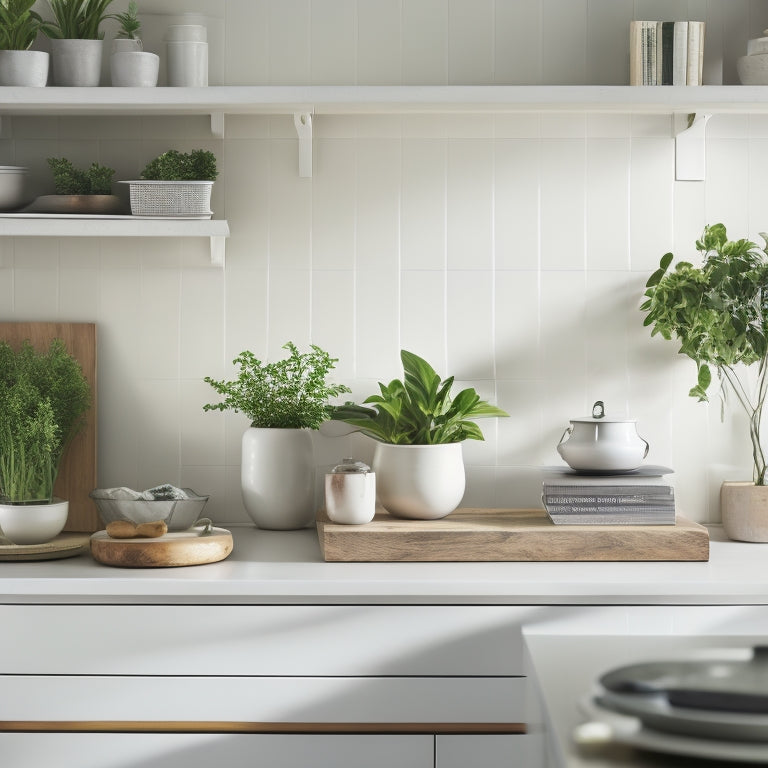
10 Small Kitchen Decluttering Transformations to Inspire
Share
You're tired of feeling overwhelmed in your small kitchen, but a few simple tweaks can make all the difference. Start by decluttering your countertops, maximizing corner space, and revamping your sink area for efficiency. Reclaim your cabinet real estate, declutter the "junk drawer," and tame the tangled utensil mess. Create a functional fridge front, turn your narrow galley into a haven, and unclutter your kitchen window sill. From categorizing items to designing a calm color palette, these small kitchen decluttering transformations will inspire you to create a space that's both peaceful and practical. Now, discover the specific strategies to make each transformation a reality.
Key Takeaways
• Categorize countertop items to identify needs and create a minimalist decor for a functional and visually appealing space.
• Maximize corner space with carousels, Lazy Susans, and hidden gems to optimize storage and efficiency.
• Streamline the sink area by upgrading the faucet, installing wall-mounted soap dispensers, and positioning drying racks for modernity and ease.
• Optimize cabinet organization by maximizing storage capacity, utilizing hidden spaces, and purging unnecessary items for a clutter-free kitchen.
• Declutter miscellaneous areas like the "junk drawer" and spice rack by purging, categorizing, and designating homes for each item to maintain a sense of order.
From Cluttered to Calm Countertops
Clear everything off your countertops and sort items into categories, like baking supplies, coffee station essentials, and frequently used appliances, to start visualizing a calm and functional kitchen space. This is the first step in transforming your kitchen from cluttered to serene. By categorizing your items, you'll identify what you need and what you can get rid of, making room for a more minimalist decor.
A calm color palette will also contribute to the peaceful ambiance you're aiming for.
Next, think about the functional layout of your countertops. Consider the workflow of your kitchen and how you can optimize it for efficiency. Place frequently used items in easy-to-reach locations, and designate zones for specific tasks, like food prep or cooking. By streamlining your countertops, you'll create a space that's not only visually appealing but also highly functional.
With a well-designed layout, you'll be able to cook, prepare, and entertain with ease, enjoying a sense of power and control in your newly transformed kitchen.
Maximizing Corner Space Potential
Optimize your kitchen's often-wasted corner space by installing a carousel or Lazy Susan, which can hold infrequently used items like special occasion dishes, cookbooks, or small appliances, keeping them accessible yet out of the way.
By maximizing your corner space, you'll create a more efficient kitchen layout. Here are some design inspiration ideas to get you started:
| Corner Shelving | Hidden Gems | Utilizing Corners |
|---|---|---|
| Install a Lazy Susan | Store infrequently used items | Create a coffee station |
| Add a corner cabinet | Keep cookbooks within reach | Design a built-in wine rack |
| Use a carousel | Stash small appliances | Build a hidden spice rack |
| Incorporate a corner shelf | Display decorative pieces | Create a utensil organizer |
| Design a built-in corner drawer | Store cleaning supplies | Make a corner desk for meal planning |
Sink Area Revamp for Efficiency
Reclaim the often-cluttered space around your sink by implementing a few strategic changes that'll streamline your cleaning and food preparation routines. A faucet upgrade can make a significant difference, providing better water pressure and a sleeker design that'll make the entire area feel more modern and efficient.
To optimize the space, consider the following adjustments:
-
Install a wall-mounted soap dispenser to free up counter space and reduce clutter.
-
Position a drying rack near the sink to dry dishes quickly and prevent water spots, keeping your countertops clear.
-
Add a small tray or dish to corral small items like sponges, scrubbers, and dish soap, keeping them organized and within reach.
Reclaiming Cabinet Real Estate
As you tackle reclaiming cabinet real estate, you'll want to focus on maximizing storage capacity by reassessing your cabinet's layout and contents.
You'll be surprised at how much more you can fit in by using stackable containers, adjustable shelves, and turntables.
Maximize Storage Capacity
You can free up a surprising amount of cabinet space by purging expired, duplicate, or unnecessary items and grouping similar items together in categories. This will give you a better sense of what you have and where it's stored, making it easier to find what you need when you need it.
To maximize storage capacity, consider the following strategies:
-
Install vertical storage solutions, such as shelves or hooks, to take advantage of the often-wasted space above your cabinets.
-
Utilize hidden pantry areas, like the space behind a cabinet door or above the refrigerator, to store infrequently used items.
-
Optimize under sink organization with slide-out drawers or baskets to keep cleaning supplies and other essentials within easy reach.
Don't forget to make the most of your cabinet doors with over door storage solutions, such as hooks, baskets, or a spice rack.
Utilize Hidden Spaces
By capitalizing on the often-overlooked areas inside your cabinets, you can uncover a treasure trove of hidden space perfect for stashing infrequently used items or kitchen gadgets.
Think of the back of a cabinet door, the space above your wall cabinets, or the narrow gap between your countertop and the cabinet above it – these are all secret storage opportunities waiting to be exploited.
Install a pegboard or adhesive hooks on the back of a cabinet door to hang utensils, spices, or even a trash bag. Utilize underutilized nooks by adding a slide-out drawer or a lazy Susan to make the most of corner spaces.
You can also attach a narrow shelf or a magnetic board to the side of a cabinet to store oils, spices, or frequently used ingredients. By reclaiming these hidden spaces, you'll be amazed at how much more organized and clutter-free your kitchen can become.
Decluttering the "Junk Drawer"
Now it's time to tackle the 'junk drawer', a notorious clutter collector in your kitchen.
You'll start by quickly getting rid of items that are broken, outdated, or simply useless, freeing up space and reducing stress.
From there, you'll organize the remaining items into categories and assign a designated home for each, creating a sense of order and control.
Purge the Clutter Fast
Tackle the 'junk drawer' head-on by dumping its contents onto a countertop or table, giving yourself a clear view of the clutter that's been accumulating. This is your chance to take control and get rid of the items that are no longer serving a purpose. You'll be surprised at how therapeutic it feels to let go of the unnecessary.
To achieve quick fixes and instant results, focus on purging items that are:
-
Broken beyond repair: If it's broken, it's time to let it go. Don't hold onto items that no longer function.
-
Outdated or obsolete: Be honest with yourself - when was the last time you used that VHS tape or floppy disk?
-
Duplicates or triplicates: If you have multiple items that serve the same purpose, keep only your favorite or the one in the best condition.
Organize Remaining Items
With the clutter purged, sort the remaining items into categories, such as writing utensils, batteries, and miscellaneous parts, to prepare them for their new homes within the 'junk drawer'. This step is vital in maintaining the organization you've achieved so far. Use drawer dividers or small containers to separate each category, making it easy to find what you need when you need it.
Next, identify items that can be stored vertically, such as stackable containers or under shelf baskets. This will maximize the limited space in your 'junk drawer' and keep similar items together. Be ruthless – if you don't need it, consider donating or discarding it.
Label each section or container using pantry labels or stickers, so you can quickly identify what's inside. This will also help you maintain the organization and prevent clutter from building up again in the future.
Designate a Home
Assign a specific spot within the 'junk drawer' for each categorized group, ensuring that frequently used items are easily accessible and less frequently used items are stored towards the back or in harder-to-reach areas. This will help you maintain your newly organized space and make the most of your storage solutions.
To take your organization tips to the next level, consider the following:
-
Group similar items together, such as all writing utensils or all phone accessories, to create a sense of cohesion and make it easier to find what you need.
-
Use dividers or small containers to separate items within the drawer and prevent clutter from building up again.
-
Label each section so you can quickly identify where everything is and maintain your decluttering strategies.
Streamlining the Spice Rack
You'll be amazed at how quickly clutter accumulates on a typical spice rack, where 20-plus jars of varying sizes vie for space, making it difficult to find the one you need.
To regain control, start by purging expired or duplicate spices. Next, consider labeling spices to make sure you can easily identify them. You can use stickers or labels, or even transfer spices to matching jars for a uniform look. This simple step will save you time and frustration in the long run.
Investing in a custom spice rack can also make a significant difference. Look for one with adjustable dividers or a rotating design to maximize storage and accessibility. This will keep your spices organized and within reach, making meal prep a breeze.
With a streamlined spice rack, you'll be able to focus on cooking rather than digging through clutter. By implementing these simple strategies, you'll be able to whip up a meal with ease and confidence, feeling more in control of your kitchen space.
Taming the Tangled Utensil Mess
To tame the tangled utensil mess, you'll need to get intentional about how you store and organize your kitchen tools.
You'll want to explore utensil organizer options that work for your space, designate a home base for each item, and contain the clutter that's accumulated.
Utensil Organizer Options
Taming the tangled utensil mess in your kitchen begins with choosing the right utensil organizer that fits your unique needs and available storage space. You've got a lot of options, and it's crucial to take into account your kitchen's layout, the types of utensils you have, and how often you use them.
Here are three utensil organizer options to keep in mind:
-
Drawer dividers: Perfect for kitchens with limited wall or counter space, drawer dividers keep utensils organized and easy to access within your existing drawers.
-
Hanging hooks: Maximize your kitchen's vertical space by installing hanging hooks near a cooking station or on the back of a door. This is ideal for frequently used utensils like spatulas, whisks, and tongs.
-
Countertop utensil holders: If you have ample counter space, think about a countertop utensil holder that can keep your most-used utensils within easy reach.
Designate a Home Base
Set aside a specific section of your kitchen as a 'home base' for your utensils, where they can be easily accessed and returned after each use, and make it a habit to put them back in their designated spot to prevent clutter from building up again. This dedicated area will become your command center for utensil organization, allowing you to efficiently prepare meals and maintain a sense of control in your kitchen.
To maximize the effectiveness of your home base, consider the following key elements:
| Element | Description | Benefits |
|---|---|---|
| Accessibility | Place utensils in an easy-to-reach location | Reduces clutter, saves time |
| Visibility | Store utensils in a transparent container | Quickly identifies contents, prevents digging |
| Proximity | Position utensils near cooking stations | Streamlines workflow, enhances productivity |
Contain the Clutter
By corralling your utensils into designated containers, you'll be amazed at how quickly you can tame the tangled mess that's been plaguing your kitchen. This is especially true for small kitchens where clutter can quickly get out of hand.
To get started, sort your utensils into categories, such as baking, cooking, and serving. Then, assign a home for each group using drawer dividers, baskets, or containers. This will prevent utensils from getting jumbled together and make them easier to find when you need them.
Here are three ways to take your utensil organization to the next level:
-
Use container labels to identify what's inside each container, making it easy to grab what you need at a glance.
-
Assign a specific utensil to a specific spot, so everyone in the household knows where to find it.
-
Store frequently used utensils in easy-to-reach locations, reserving harder-to-reach spots for less frequently used items.
Creating a Functional Fridge Front
What's holding you back from maximizing the prime real estate on your fridge front, and how can you transform it into a hub of functionality and organization? It's time to rethink the way you use this valuable space.
Start by creating a magnet display that showcases your favorite spices, oils, or frequently used ingredients. This won't only free up cabinet space but also keep your essentials within easy reach.
Next, get creative with labels. Design and print custom labels that categorize your fridge contents, such as 'Leftovers,' 'Beverages,' or 'Snacks.' This visual system will help you quickly identify what's inside your fridge, making meal planning and grocery shopping a breeze.
You can also use labels to designate specific zones for different family members or meal prep areas. By implementing these simple yet effective strategies, you'll be able to find what you need in seconds, reducing food waste and saving time in the process.
With a functional fridge front, you'll be empowered to take control of your kitchen and cook with confidence.
Turning a Narrow Galley Around
Transform your narrow galley kitchen into a culinary haven by tackling its biggest constraint: limited floor space. You can create the illusion of more space by implementing clever space-saving techniques. For instance, consider installing:
-
Vertical storage: maximize your kitchen's vertical space by using wall-mounted shelves, hooks, and racks to store less frequently used items.
-
Narrow appliances: opt for slimline appliances, such as compact refrigerators and dishwashers, to free up floor space.
-
Fold-down tables: install fold-down tables or countertops that can be easily stowed away when not in use, providing additional counter space when needed.
In addition to space-saving techniques, thoughtful lighting solutions can also make a significant impact. Consider installing LED strip lighting under your cabinets to create a sense of brightness and airiness.
A well-chosen color scheme and decor accents can also contribute to a sense of openness and sophistication. By incorporating these elements, you'll be able to turn your narrow galley kitchen into a functional and stylish space that inspires culinary creativity.
Uncluttering the Kitchen Window Sill
Now that you've optimized your kitchen's floor space, it's time to tackle the often-neglected kitchen window sill, which can quickly become a cluttered mess of plants, decorative items, and miscellaneous knick-knacks.
This area is prime real estate for maximizing natural light and showcasing your favorite plants. Start by removing everything from the sill and sorting items into categories. Be ruthless – if you don't use it or love it, consider letting it go.
Next, create a cohesive plant display by grouping similar plants together or arranging them by size. Consider using a tiered planter or a decorative tray to add visual interest. Leave some space between plants to avoid overcrowding and allow for easy maintenance.
Frequently Asked Questions
How Do I Maintain My Decluttered Kitchen After the Initial Transformation?
You'll maintain your decluttered kitchen by establishing daily habits, like wiping down counters and putting away dishes, and implementing organization tips, such as designated storage solutions, to prevent clutter from building up again.
What Are Some Eco-Friendly Alternatives to Traditional Kitchen Cleaning Products?
You can ditch harsh chemicals for eco-friendly alternatives like reusable cloths and homemade solutions made from vinegar, baking soda, and lemon juice, which are effective, non-toxic, and budget-friendly, allowing you to clean with a clear conscience.
Can I Declutter My Kitchen Without Spending a Lot of Money?
"You're not alone: 75% of Americans feel overwhelmed by clutter. You can declutter your kitchen without breaking the bank! Start with budget-friendly organization hacks like repurposing containers and embracing a minimalist kitchen aesthetic to maximize space and simplicity."
How Do I Involve My Family Members in the Kitchen Decluttering Process?
You involve your family members in kitchen decluttering by assigning tasks, setting goals, and making it fun; provide organizing tips, like categorizing items and creating a 'maybe' box, to guarantee everyone's on the same page.
Are There Any Specific Decluttering Strategies for Kitchens With Limited Natural Light?
Like a canvas waiting for art, your kitchen's limited natural light is a blank slate; exploit it with strategic lighting solutions, clever organization tips, and feng shui-inspired minimalist decor to create a bright, airy space that's both functional and inviting.
Related Posts
-

Design Your Dream Closet With Online Software
With online software, you can transform your closet into a personalized retreat that reflects your unique style, effo...
-

Why Declutter Your Home Office Matters
You'll be amazed at how a clutter-free home office can alter your work life. By decluttering, you'll enhance your pro...

